Vanuatu 2012
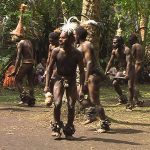 |
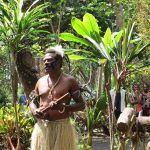 |
| Dravai Village | Welcome to Vanuatu |
Wow! What a season. It was NOT uneventful.
We returned to Vuda Marina in May, 2012. Entr’acte was in impeccable condition thanks to Mr. Bharos who took care of Entr’acte like she was his own. Everyone we met remarked at how diligent he was in his care for her.
This was to be a very quick re-commissioning as we did not have a tremendous amount or work to do. Ed would attend to the general cleaning while Ellen would complete her cushion replacement project from last season. The only thing that remained was to make the new covers for the main cabin cushions and finish off the new cockpit enclosure. Like last season, we chose to spend several nights at First Landing resort Bure No. 2. With this arrangement, Ed could work on Entr’acte freely and make as big a mess as was necessary to get the job done and Ellen could sew in air conditioned comfort. At the end of the day we could retire to the pool and have a good nights sleep away from all the mess.
 |
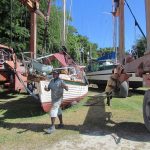 |
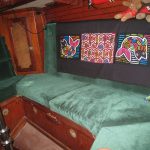 |
| Bure No. 2 | Coming out of the “grave” | New Cusions |
The days flew by and we met many new friends from all over the world. Two boats away were Carolyn and Tony from Australia who had just purchased their dream boat Tuaki and were hard at work preparing her for this years cruising season in Fiji before setting out to explore the world. Typically we knew only their first names and the name of the boat that was enough. They became “Mr and Mrs Tuaki” while we were “Mr and Mrs Entr’acte.” Our relationship with them as with many other boats in the yard was confined to quick greetings as we passed each others boats on the way to the market, the shower or to the office. We gave each other a helping hand from time to time as needed but otherwise we were all focused on our own jobs and problems. Our main social contact was a quick beer at at the Sunset Bar at the end of the day.
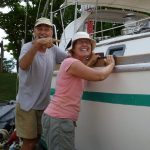 |
| Tony and Carolyn |
One afternoon as we passed Tuaki Carolyn looked up from scraping her teak rail and called out “see you at Sunset Bar at 6:30.” We waited at the bar for over an hour and just as we were about to leave Tom from Tom Boy walked in looking somber. He informed us that within the past hour and a half Carolyn had suddenly suffered a massive cerebral hemorrhage and had died. She was only 51 and appeared in perfect health. Her attack came just minutes after we had seen her and despite the heroic efforts of Tom’s wife Jan who is a Dr., two other doctors with a defibrillator, a nurse, and an acupuncturist, they could not save her. We were all devastated.
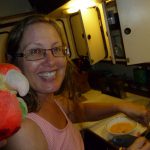 |
| Carolyn Pike |
The next weeks were taken up with all sorts of red tape and officialdom. As usual the cruising fraternity all came together even though none us really knew each other at all. This was a heck of a way to get to know someone. We planned a memorial service for Carolyn and everyone dropped what they were doing to attend. Of course of the yachts attended but also, the entire marina staff stayed and supplied coffee, tea and cake at no charge. The fuel dock attendants and the travel lift operators stayed after hours to attend and then the “Cavalry” arrived. The entire staff and management of the First Landing Resort came en mass dressed for the occasion and literally took overthe service and do things “Fiji Style.” The musicians played and they all sang. The ceremony ended with everyone floating lighted candles out to sea at sunset.
 |
| First Landing Choir |
Tony took Carolyn’s remains back to Australia and everyone drifted back to their boats and projects as we all prepared for our departures.
On June 28, we said a very tearful good-bye to Bharos and Mohammed. After two seasons in Fiji they had become dear, dear friends. It is crushing to say good-bye when everyone knows that we will never see each other again. Our last vision of Fiji was of Bharos and Mohammed standing and waving long after we were far out to sea.
 |
| Bharos and Mohammed -The Best! |
We wanted to clear Fiji customs at 08:30 so we could run the 25 miles and get through the pass before dark but we went soft aground on our way into Lautoka and lost 10 precious minutes. By the time we arrived at customs there were several boats in front of us and we could not get cleared out until 13:00. We made a dash for it but alas we could only get as far as Momi Bay by sunset and even though the pass was just ahead we decided to anchor in Momi for the night and get a fresh start in the morning. It is against the rules but we were very tired and prudence dictated that we play it safe. It turned out to be a very goods move.
Sunrise of June 29, 07:00, 2012 saw Entr’acte under weigh for Vanuatu 500 miles to the West. Despite the forecast of 15 to 20 knot winds we motored out through the pass onto a lumpy, windless sea. There was a large swell coming from a storm in the Southern Ocean and we were not at all comfortable. Waiting for morning had been a great idea. Had we departed last night we would have had a miserable first night. As it was the first two days were rugged and a bit of a challenge.
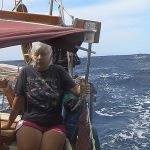 |
| A rough start |
The entire passage was a mix of light wind and no wind. Our Mainster again came to the rescue. This passage was unusual because we both went through bouts of sea sickness which was very unusual. The wind finally filled in but from the SW which was not forecast and put us hard on the wind. For a while it looked like we would not be able to make intended landfall at Anietym but would have to settle for Port Villa. That would be tragic because just like Fatu Hiva in French Polynesia, if you miss Anietyum you can not get back as it is directly into the trade winds. In the end, King Neptune was kind and gave us a favorable wind shift which allowed us to make landfall in the delightful Anelgowhat Bay on the island of Anietyum; and not a moment too soon. By midnight it was blowing 30 knots and it continued that way for then next two weeks.
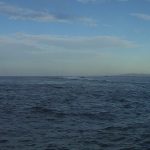 |
 |
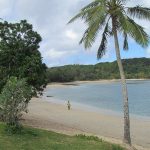 |
| Landfall Vanuatu | Richard the Policeman | Anietyum Vanuatu |
Vanuatu, formerly called the New Hebrides, is an archipelago of volcanic origin which sits west of 400 miles west of Fiji approximately 1,000 miles east of northern Australia and 300 miles northeast of New Caledonia, with the Solomon Islands and New Guinea to the Northwest. Each island in the group has it’s own completely different personality, appeal, and even language. Bislama (a form of Pidgin English) is the main language of Vanuatu with English and French being equally distributed. To further complicate things, each island can have it’s own dialect of Bislama. Visiting these islands could prove to be a challenge.
 |
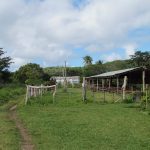 |
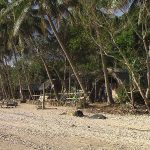 |
| Anelghowhat Vanuatu | Main Street | Anelghowhat Village |
As a landfall, Anietyum (Anatom) was a great choice. The island is very quiet. There are no motor vehicles of any kind. No electricity, running water, TV, internet or satellite dishes anywhere on the island. If it grows in the jungle, they eat it or use it. If it can not be found in the jungle they do without it. The only concession is to small outboard motors for a few old fiberglass boats. Despite this basic living, Anietyum enjoys a very high level of culture, good health and their own school. Volley ball is played at a very high level of. There are several villages around the island and the competition is fierce and non-stop. The competing villages must walk the foot path 3 to 4 miles, play the game and then walk home again.
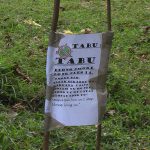 |
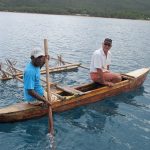 |
| Tabu! | Vanuatu taxi service |
The Ni Vanuatu are extremely friendly but incredibly shy. They would paddle their canoe silently up to Entr’acte and if we did not see or hear their approach, would sit in absolute silence until one of us came on deck to discover their presence. Their normal speaking voice is almost a whisper. In all the time we were in Vanuatu no one ever begged for anything. They were extremely interested in who we were and where we came from. If we spent a bit of time speaking with them they would invariably return a bit later with a gift of some fruit as a thank you for our time.
As in all small communities word travels fast. One windy morning Kieth paddled up to us and after the usual long, slow conversation he asked us “is it true that you built this boat?” When we said yes he asked us if we might know something about fiberglass repair. The village had been given an old beat up fiberglass boat by a tourist company but it had huge holes in the bottom and could not be used. Kieth went on to say that a few years ago, someone had given them “liquid and cloth” but no one knew how to use it. Could we help? Thus began the Entr’acte boat repair school which turned into a community “save the village boat” project.
Keith had the material, Robertson owned the grinder, Kenneth owned a gasoline powered generator and Captain Ed supplied the rubber gloves, acetone, mixing sticks and paper cups. There was not one tin can or paper cup anywhere on the island.
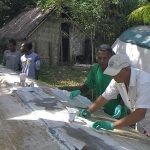 |
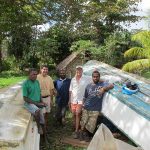 |
| Teaching boat repair | A job well done! |
For the next two days the entire village turned out for instruction on how to properly grind fiberglass and to mix and apply polyester resin and cloth. They learned about ambient temperature and how to vary the amount of catalyst according to the ambient temperature (dont forget what I said above about the language). Ed supervised and acted as foreman directing the Ni Vanuatu in the repair. On launching day Ed cautioned everyone. “This was a huge repair. We only addressed the very large openings and probably did not find all of the small leaks. The boat will probably still sink. It will just take a lot longer.” This brought a huge laugh from the crowd. At dawn the boat was launched to a mighty cheer from the village and floated without a leak.
Two days later George came by. “Do you think you could help me with my boat? I have some material also.” This time it was epoxy resin and again the school was convened. This time they all had to learn about a “proper 4 to one mix ratio.” Once that was explained, Ed stood back and directed as Keith took charge and directed Robertson, Kenneth and George in the repair.
 |
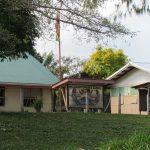 |
| Knock to enter the Village | Anghelowhat School |
The wind finally moderated and we had a favorable wind to set out for Port Resolution on the island of Tanna. We wanted to see the Kastom village of Yakel as well as the active Yassur volcano. It was only 50 miles but it was a hard go. Even though we had a steady favorable wind behind us we encountered contrary swell from many different directions as well as williwaws as the wind shifted and accelerated between the islands. Again, we were sea sick which caused us great concern. As we approached Tanna we could see and hear Yassur “doing it’s thing!” Pretty spectacular even in daylight. Unfortunately Port Resolution is not a great anchorage. As long as the wind remained in the SE we would be safe but uncomfortable as the swell always finds its way into the harbour and causes a constant rolling. If the wind went NE however, we would have to clear out instantly as the harbour would become unsafe. Our time there would be limited, we had none to waste.
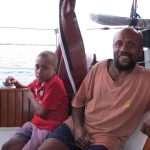 |
| Afternoon visitors |
Tanna is much larger and a bit more developed than Anietyum in that it has a road and there are a few 4WD trucks. 4 Wheel is an absolute necessity here with the steep hills and muddy roads all through the jungle. The first step of the journey is up the mountain via 4×4 arriving at the base of the volcano just at dusk. This is a class “A” active volcano in every way. Vulcanologists from all over the world come here to study Yassur. There were quite a few sitting with boots and hard hats watching and taking notes even as we arrived.The locals have a safety scale of 1 to 4. We caught Yassur at level 2 which they felt was safe. At level three they will not take anyone up there and at level 4 they are fighting for survival down in the villages.
The Yassur Volcano was breath-taking. It was like standing in the middle of a fireworks display. It is easy to understand why the ancients looked at volcanoes as gateways into Hell.
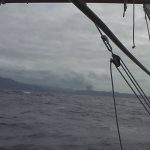 |
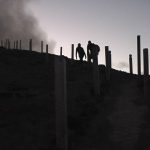 |
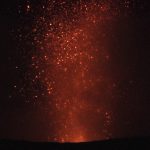 |
| Yassur Volcano | Hike to the crater rim | Crater Rim |
On the third day the wind went to the NE and we had to bug out. Next stop, the city and capitol Port Villa on the island of Efate.
Port Villa was a real city. It had everything a city should have. Cars, busses,cruise ships, airplanes and traffic. Busy,busy! Quite a contrast to the southern islands. We could finally dispose of our trash which we had to carry and contain since departing Fiji six weeks ago. The outer islands just did not have the resources to handle anyone else’s trash but their own. We could finally top up on diesel fuel, gasoline for the OB and Kerosene for our cooking stove. We were running low on everything, even food. The super markets and Farmers market soon took care of that. We could finally do some laundry as well. This was a welcome bit of civilization. The first we had seen since Lautoka in Fiji 6 weeks ago. Unfortunately it rained every single day we were in Villa. It never seemed to stop. We never saw the sun—at all!
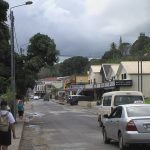 |
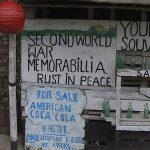 |
| Port Villa | WWII Museum |
June is supposed to be the dry season but there was a trough of low pressure that just developed over Vanuatu and refused to diddipate. Day after day turned into week after week and the trough just hung there and with it RAIN! The entire time we were in Vanuatu it rained. Some days a lot, other days a little but it was always there with little exception. It was maddening!
We desperately needed to have our outboard motor repaired. The service people immediately found the problems–we needed as new propeller and a carburetor rebuild but they had no parts and to have them sent in would take six weeks–not an option. They made a makeshift repair by cannibalizing parts from other engines and we were back in business–sort of–but it was the best we could do.
Our next stop was the Port Sandwich Cultural Festival on the island of Malekula. It was only 80 miles away but again it was a rugged trip. No matter what we tried we could just not get comfortable and were seasick most of the way. Approaching the Maskelyne Islands we were so sick that we decided to heave to just to try and eat something in some sort of comfort. This was that first time ever that heaving to failed to provide any comfort and even proved to be worse than remaining under weigh. What was happening? It seemed as if we were sitting in a giant bowl of water that was being shaken at random causing waves to come from all directions at once.
We finally came abeam of Port Sandwich Channel and made the turn to enter, the wind funneling through the gap between Ambrym Is and Pentecost Is blew like nothing we had seen in a long time. Fortunately the wind was astern so it’s effect was short lived. However, we began to worry about what it was going to be like to exit this harbour. Once around the point, the wind shut off completely and we anchored in absolutely flat, quiet water, our first really quiet anchorage two months but, it was still raining!
There were already 6 yachts anchored at Sandwich for the Festival and they all were complaining about what a rotten trip they had. It was only a bit later that another yacht arrived and said “what did you think of the earthquake?”
Vanuatu begins what is known as “the Rim of Fire,” an area of extremely active volcanoes as well as frequent, sometimes very strong seismic activity. This area extends from Vanuatu all the way through Malaysia and Indonesia. This is the area of the famous Krakatoa eruption of the 1880’s. It turned out that we really were sailing inside a bowl of water being shaken at random—-a number 6 underwater earthquake all along the passage we had just made. An interesting experience that we would prefer not to repeat.
Like Anietyum, Malekula has no infrastructure. There are many villages but no cities. A few gasoline generators provide a bit of power in the larger villages and there are a few 4 WD vehicles to aid in unloading the freight boats that come weekly. Otherwise everyone walks and this proved to be a lot more difficult than you might imagine.
The constant rain made for very muddy, slippery walking through constant jungle. The roads were little more than a dirt path and mud pools to block the way. Without 4WD a vehicle would be stranded immediately. As we walked to the villages we, like the locals never used the roads. Rather, we all worked our way along an improvised foot path through the adjoining grass. Out first lesson in “jungle craft” was to follow the locals and walk where they walked. The villagers taught us that to walk safely we had to learn how to “read the jungle” just as we might read the water navigating through coral. We caught on quickly but we now have a completely;y new respect for the American soldiers who fought in these same jungles during WWII.
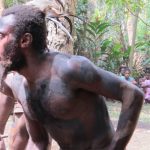 |
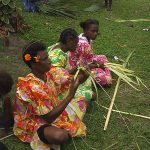 |
| Scary! | Ladies of Dravai |
The Port Sandwich festival was “over the top!” Out of a possible 10 we give it a “50.” The rain seemed to come and go at just the right time for all of the events to take place as planned. The Chief said that they all danced and prayed for the Gods to control the rain for the festival to be a success.
For three days we enjoyed the Kastom Village of Lamap. What an event. The kindness and hospitality of the entire village was overwhelming. When they all assembled to sing their welcome song we all started to cry. The dancing was wonderful and the food non-stop. Everything they served came directly from the jungle and their own private livestock. If Nature and the Jungle does not provide it, they don’t need it.
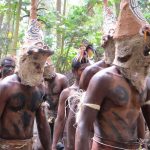 |
 |
| Cobweb men | They work hard! |
This festival is a real “Don’t Miss!”
It was now mid-August and it had become quite obvious that Malekula was as far North as we could go in Vanuatu If we wanted to have any time left to enjoy New Caledonia before the start of the cyclone season. We had to work our way back to the South to acquire a reasonable sailing angle for the passage. If we departed from Port Villa we would be close hauled to windward but it would be possible. To depart from here or farther North would put us too close to the wind and make for a difficult trip.
As the Festival began our weather maps showed a very short window for us to return to Port Villa if, and only if, we left Port Sandwich on Sunday afternoon immediately after the Festival’s final dance. If we waited even until the next morning we would miss this opportunity and have to wait in Port Sandwich for perhaps another week or more for the next weather window. Out here, to hesitate for even 6 hours could cost you a week or more. Much as we did not want to leave, we all decided to bug out.
Feeling like two exhausted stuffed turkeys, we departed Port Sandwich at 17:00 with just enough light to exit the pass. Because of the favorable wind shift, the exit was easy and not at all as boisterous as our entrance. No earthquakes this trip and we sailed comfortably over night to make landfall on Efate just after dawn. The wind built constantly overnight and by dawn it was again raining steadily and blowing a good 20 knots astern but Villa was in sight. By 07:30 It was raining so hard that we had to use our departing gps track and old waypoints just to find our mooring off the yacht club. We were all very glad that we moved when we did as the weather remained vile for the next 5 days. We made all of our preparations to depart Vanuatu amidst torrential rain.
Despite the horrible weather and constant rain, Vanuatu was an absolute delight. It is truly an exotic country full of contrasts. The Ni Vanuatu as indeed as friendly as the Fijians, the only difference being that the Fijians ebullience is in direct contrast to the extreme shyness of the Ni Vanuatu. It was a fascinating cultural experience. If only it would not rain so much.
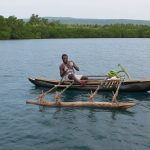 |
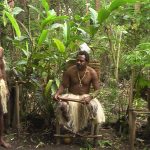 |
| Kenny the Banana Man | Chief George |